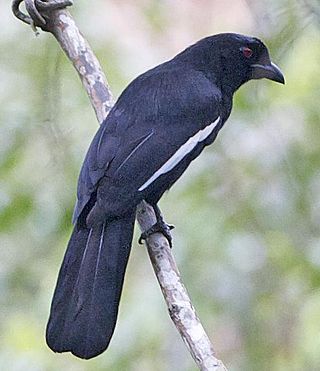
The treepies comprise four closely related genera of long-tailed passerine birds in the family Corvidae. There are 12 species of treepie. Some treepies are similar to magpies. Most treepies are black, white, gray or brown. They are found in Southeast Asia. They live in tropical forests. They are highly arboreal and rarely come to the ground to feed.

The rufous treepie is a treepie, native to the Indian Subcontinent and adjoining parts of Southeast Asia. It is a member of the crow family, Corvidae. It is long tailed and has loud musical calls making it very conspicuous. It is found commonly in open scrub, agricultural areas, forests as well as urban gardens. Like other corvids it is very adaptable, omnivorous and opportunistic in feeding.

The collared treepie, also known as black-faced treepie or black-browed treepie, is an Asian treepie, a small perching bird of the crow family, Corvidae.

The grey treepie, also known as the Himalayan treepie, is an Asian treepie, a medium-sized and long-tailed member of the crow family. The species was first described by Robert Swinhoe in 1863. They are widely distributed along the foothills of the Himalayas in the Indian Subcontinent and extending into Indochina, southern mainland China and Taiwan. The populations vary in plumage and several are named as subspecies.

The white-bellied treepie is a bird of the crow family endemic to the forests of southern India. They overlap in distribution in some areas with the rufous treepie but are easy to tell apart both from appearance and call.

The long-billed partridge is a species of bird in the family Phasianidae.

The crowned bullfrog is a species of frog in the family Dicroglossidae. It is found in the Sub-Saharan Africa . Its natural habitats are subtropical or tropical moist lowland forest, dry savanna, moist savanna, subtropical or tropical dry shrubland, subtropical or tropical moist shrubland, subtropical or tropical dry lowland grassland, subtropical or tropical seasonally wet or flooded lowland grassland, rivers, intermittent rivers, freshwater lakes, intermittent freshwater lakes, freshwater marshes, intermittent freshwater marshes, freshwater springs, arable land, pastureland, rural gardens, heavily degraded former forest, and ponds.

The blue-crowned chlorophonia is a species of bird in the family Fringillidae. It is found in El Salvador, Panama, Guatemala, Honduras, Mexico, and Nicaragua. Its natural habitat is subtropical or tropical moist montane forest.

The hooded treepie is a species of bird in the family Corvidae. It is endemic to Myanmar.

The Andaman treepie is a species of bird in the family Corvidae. First described by Robert Christopher Tytler in 1863, it is endemic to the Andaman Islands of India, where its natural habitat is subtropical or tropical moist lowland forests. It is threatened by habitat loss.

The midget flowerpecker is a species of bird in the family Dicaeidae. It is found in the Solomon Islands archipelago. Its natural habitats are subtropical or tropical moist lowland forest, subtropical or tropical mangrove forest, and subtropical or tropical moist montane forest.

The olive bushshrike is a species of bird in the family Malaconotidae. It is found in Malawi, Mozambique, South Africa, Eswatini, and Zimbabwe. Its natural habitats are subtropical or tropical dry forest, subtropical or tropical moist lowland forest, subtropical or tropical moist montane forest, and subtropical or tropical dry shrubland.

The Samoan flycatcher is a species of bird in the family Monarchidae. It is endemic to Samoa. Its natural habitats are subtropical or tropical moist lowland forests, subtropical or tropical moist montane forests, and rural gardens and is threatened by habitat loss.

The Malayan black magpie is a species of bird in the family Corvidae. Despite its name, it is neither a magpie nor, as was long believed, a jay, but a treepie. Treepies are a distinct group of corvids externally similar to magpies.

The southern martin is a species of bird in the family Hirundinidae.

The ratchet-tailed treepie is a species of bird in the crow and jay family Corvidae. The species is also known as the notch-tailed treepie. It is monotypic within the genus Temnurus.

The dull-coloured grassquit is a small bird. It is recognized as a tanager closely related to Darwin's finches.

The rufous-vented yuhina is a bird species in the white-eye family Zosteropidae. It is found along the northern parts of the Indian subcontinent, primarily in the Eastern Himalayas, and ranges across Bhutan, India, Tibet, Myanmar, and Nepal. Its natural habitat is subtropical or tropical moist montane forests.

The Bornean treepie is a passerine bird belonging to the treepies genus, Dendrocitta, of in the crow family, Corvidae. It is endemic to the island of Borneo. It is sometimes treated as a subspecies of the Sumatran treepie.

New Amarambalam reserved forest is a reserved forest in the Western Ghats, situated in the Malappuram District of Kerala state of India. It extends till Silent Valley National Park of the Palakkad District to the south and to Nadugani in the Nilgiri District of Tamil Nadu to the North. It is under the Karimpuzha Wildlife Sanctuary.




















